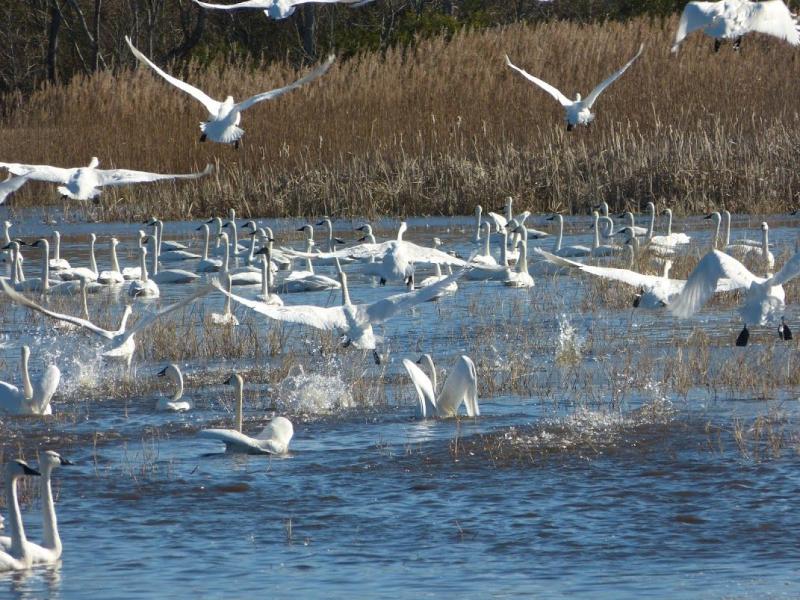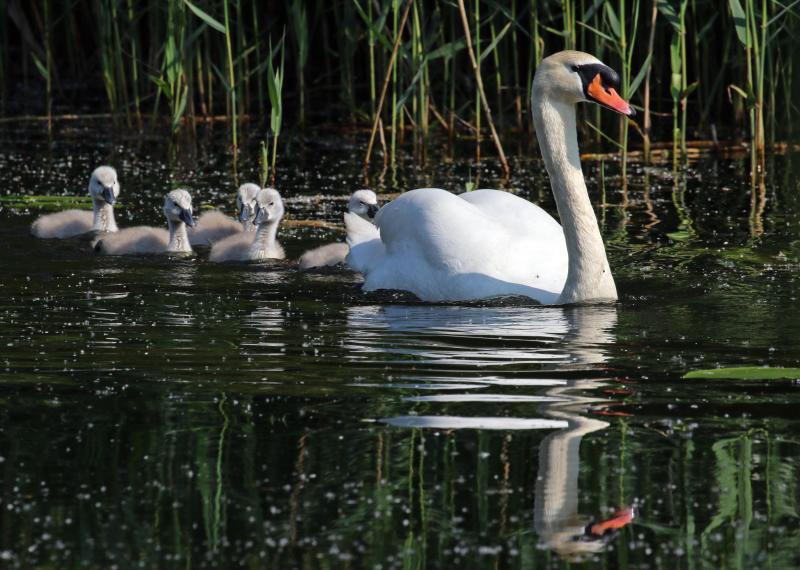Great Big White Birds
 A flock of tundra swans in their normal wintering range along the coast of North Carolina. A tundra swan made a rare visit to Maine recently. Photo: Allie Stewart/USFWS, courtesy Wikimedia Commons
A flock of tundra swans in their normal wintering range along the coast of North Carolina. A tundra swan made a rare visit to Maine recently. Photo: Allie Stewart/USFWS, courtesy Wikimedia Commons
 Mute swans have occasionally bred in southern Maine. Despite their demure appearance, they are often aggressive toward other waterfowl and to people. Photo by Charles J. Sharp, courtesy of Wikimedia Commons
Mute swans have occasionally bred in southern Maine. Despite their demure appearance, they are often aggressive toward other waterfowl and to people. Photo by Charles J. Sharp, courtesy of Wikimedia Commons
 A flock of tundra swans in their normal wintering range along the coast of North Carolina. A tundra swan made a rare visit to Maine recently. Photo: Allie Stewart/USFWS, courtesy Wikimedia Commons
A flock of tundra swans in their normal wintering range along the coast of North Carolina. A tundra swan made a rare visit to Maine recently. Photo: Allie Stewart/USFWS, courtesy Wikimedia Commons
 Mute swans have occasionally bred in southern Maine. Despite their demure appearance, they are often aggressive toward other waterfowl and to people. Photo by Charles J. Sharp, courtesy of Wikimedia Commons
Mute swans have occasionally bred in southern Maine. Despite their demure appearance, they are often aggressive toward other waterfowl and to people. Photo by Charles J. Sharp, courtesy of Wikimedia Commons
All-white birds are not something we see very often in Maine. Egrets are all white, but they’re not exactly “great big,” not even the “great egret.” There are only a few options for what a really big white bird could be. White pelican is one species. The other possibilities are the swans.
There are two species of swan that are native to North America (tundra and trumpeter). A third (mute swan) was introduced from its Eurasian range and is now established, and a fourth (whooper swan) is a rare visitor to Alaska and the West Coast, from Europe and Asia. All four have occurred in Maine, although the whooper swans that have been found here are all thought to have originated from escapes from captive waterfowl collections.
All four of these swans look pretty similar. The only distinguishing features come down to the color of the legs and bill, and various differences in shapes of head, neck, and bill, most of which are often very subtle.
The very earliest written accounts of birds in Maine starting in the 1600s include mention of large, white swans. Back in those days, no one knew what the different types of swan even were. Now we know that there were two possible species: tundra swans and trumpeter swans.
Tundra swans nest in the Arctic and sub-Arctic regions of Canada across to Alaska (there is also a Eurasian subspecies often referred to as Bewick’s swan). Birds nesting from the northern crown of Alaska eastward across northern Canada winter along the Atlantic Coast, usually from New York to the Carolinas. Birds nesting along the southwest coast of Alaska winter along the Pacific Coast and inland parts of the western U.S.
A swan spotted a few weeks ago on Sebasticook Lake in Newport after careful inspection turned out to be an immature tundra swan. It has been staying put and delighting many birders who’ve made it over for a look. Interestingly, there have been single immature tundra swans spotted about the same time in New Brunswick and way up in Goose Bay, Labrador. They are also rare visitors in both of these places.
Trumpeter swans, on the other hand, were thought to have nested across much of the northern U.S. and interior Canada to Alaska. Unfortunately, from the earliest days of European colonization, swans were aggressively hunted for food and for their feathers. Thus they disappeared in many areas before Western science documented their range. Perhaps the swans that were documented back in the 1600s were trumpeter swans, but whether they occurred regularly is another unknown.
Mute swans, swimming along with their bills pointed down so their necks have a gentle curve, are the swans that are probably the species most familiar to most people. Despite their name, mute swans actually make a variety of sounds—grunts, hisses, and soft trumpeting vocalizations.
Mute swans were kept by European nobles as a status symbol dating as far back as the Middle Ages. Today they are often seen at zoos, animal parks, farms, and other places. Mute swans were first introduced into parts of the U.S. and Canada beginning in the late 1800s. Breeding populations didn’t become established largely until after the 1920s. Today, they occur along the Atlantic Coast from southern Maine (occasionally breeding) south to North Carolina and around the Great Lakes region, and in a restricted region of southern British Columbia.
As winter snows descend on Maine, we expect the tundra swan will depart for warmer climes. Soon we’ll be on the look-out for other white birds: snow buntings and snowy owls!
Jeffrey V. Wells, Ph.D., is a Fellow of the Cornell Lab of Ornithology and Vice President of Boreal Conservation for National Audubon. Dr. Wells is one of the nation's leading bird experts and conservation biologists. He is a coauthor of the seminal “Birds of Maine” book and author of the “Birder’s Conservation Handbook.” His grandfather, the late John Chase, was a columnist for the Boothbay Register for many years. Allison Childs Wells, formerly of the Cornell Lab of Ornithology, is a senior director at the Natural Resources Council of Maine, a nonprofit membership organization working statewide to protect the nature of Maine. Both are widely published natural history writers and are the authors of the popular books, “Maine’s Favorite Birds” (Tilbury House) and “Birds of Aruba, Bonaire, and Curaçao: A Site and Field Guide,” (Cornell University Press).
























